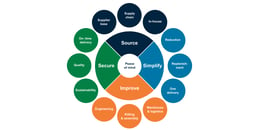- Insights
- The Solutionists Hub
- C-Parts Purchasing: Handling Your Sustainable Purchasing Policy
C-Parts Purchasing: Handling Your Sustainable Purchasing Policy

Sustainability is one of the top agenda items for manufacturing companies, and purchasers can make a real difference in reducing supply chain emissions and contributing to the company’s overall sustainable ambitions.
With increasing pressure from customers and regulators to start measuring, reporting and reducing emissions, it’s not a surprise that most large manufacturers have adopted a sustainability policy to guide the entire organization’s move towards sustainable operations.
For purchasers who already face pressure to source the right parts at the right price from reliable, punctual suppliers, sustainability is another important metric to add to the decision-making process. In this article, I want to share my experiences and give some advice to purchasers on how to integrate sustainable practices into their work and help make their company’s sustainability policy a reality.
Communication and values are key for sustainable purchasing across the company
This may not be an issue for purchasers at small to medium-sized companies, but if you work for a multinational organisation, you probably have a lot to balance. It can sometimes be difficult to combine your own national standards and regulations with the organisation’s global policies, especially in companies that are truly worldwide. This applies across the company, but it’s definitely the case in sustainability-focused purchasing offices that have to juggle multiple carbon-related regulations and sustainability reporting standards.
In situations like this, tight communication and collaboration between markets is highly valuable. It is always useful to share ideas and experiences, even if your day-to-day sustainability work and national standards look very different.
A common sustainability policy, or at least a set of shared values related to sustainability, can be a great tool to enhance sustainability across the purchasing organisation. In my experience it can help each member of the team push in the same sustainable direction, even when the specific sustainability goals and regulations we deal with are different.
Be aware of sustainability trends and developments
As a purchaser, you play a core role in putting your company’s sustainability policy into action and making a difference to your company’s carbon emissions. After all, scope 3 emissions generated in the supply chain stand for well over 70% of the total greenhouse gas emissions for most manufacturing companies.
It’s obviously important to comply with the sustainability policy, but the purchasing department should aim to be one step ahead. When market demands and regulations are making sustainability a business necessity, the guidelines in your policy are likely to get stricter in future, especially if they are still quite vague today.
In the coming years, working in an unsustainable way will become more and more expensive for manufacturers – so to avoid having to make drastic changes in future, start making many small ones today by staying updated on the market situation and working continuously to improve your sustainable purchasing practices.

Map and monitor emissions to gain control and meet demand
Making sustainable changes in your supply chain and complying with your sustainability policy means fully understanding your current situation.
Mapping emissions should be the first step for any purchasing department starting a sustainability journey. Assessing your scope 1 and 2 emissions, which your company is directly responsible for, is a central part of the process. But measuring the largest group of emissions in scope 3 is essential in the long term.
Here, collaborating closely with suppliers is vital, since they are your source of crucial information on emissions, which will become essential as regulations like CBAM tighten the requirements on emissions reporting and begin to raise the price of importing carbon-intensive goods.
Improving the quality of emissions reports over time will also require collaboration between suppliers and customers like us. Many suppliers are not at the forefront like Bufab is, and are still struggling to track the emissions generated in the early stages of their supply chain, such as in manufacturing and raw material extraction. Over time, this will change — but only if manufacturing companies start moving in the same direction in their aim to get a true picture of their emissions and overall sustainability.
In future, these detailed emissions insights will be needed for meeting customer demands. Already, my company is facing sustainability requirements from customers related to the level of recyclable materials in our products, or the emissions generated during transport.
If requirements like these haven’t affected your company yet, they will soon. But through good internal cooperation, global awareness and accurate emissions monitoring, you should be able to adapt to the demands of the future.
Thanks to Kadi for contributing to this article — to keep learning more about the significance of C-parts in your company's sustainability work, make sure to read our guide to sustainability in the C-parts supply chain.
And click below to download our presentation on the key sustainability trends you should be aware of as a C-parts purchaser at a manufacturing company.
Get new knowledge every week!
Related
-
By Sergio BrambilaSustainability targets and KPIs to implement in the purchasing department
-
By Patrik Lundström TörnquistSustainability Challenges With C-Parts, and How to Manage Them
-
By Carina LööfSustainable C-Parts: What You Need to Know
-
By Niklas LindsköldCBAM: How will it affect European manufacturers?
-
By Niklas LindsköldHuman rights due diligence: Is your supply chain under control?
-
By Niklas LindsköldChemical compliance: What manufacturing companies need to know
-
By Niklas LindsköldConflict minerals: How to avoid them in your manufacturing operation










